Business Project Report: Assessing Equality and Diversity at IKEA
VerifiedAdded on 2022/11/24
|19
|4490
|150
Report
AI Summary
This report analyzes IKEA's equality and diversity project, exploring its aims and objectives, which include understanding the concept of equality and diversity within IKEA, identifying the benefits of these practices, and examining implementation strategies. The report details the project management plan, including cost, scope, time, communication, and quality considerations. It uses a Work Breakdown Structure (WBS) and a Gantt chart for time management and strategy. The research employs both primary and secondary methods, including questionnaires and literature reviews. Data analysis is conducted using various tools and techniques, followed by recommendations and reflections on the project's findings. The report concludes with a discussion of the impact of equality and diversity on organizational performance and provides insights into IKEA's practices in this area. Appendices include performance reviews and a project log book.

Managing a successful
business project
business project
Paraphrase This Document
Need a fresh take? Get an instant paraphrase of this document with our AI Paraphraser
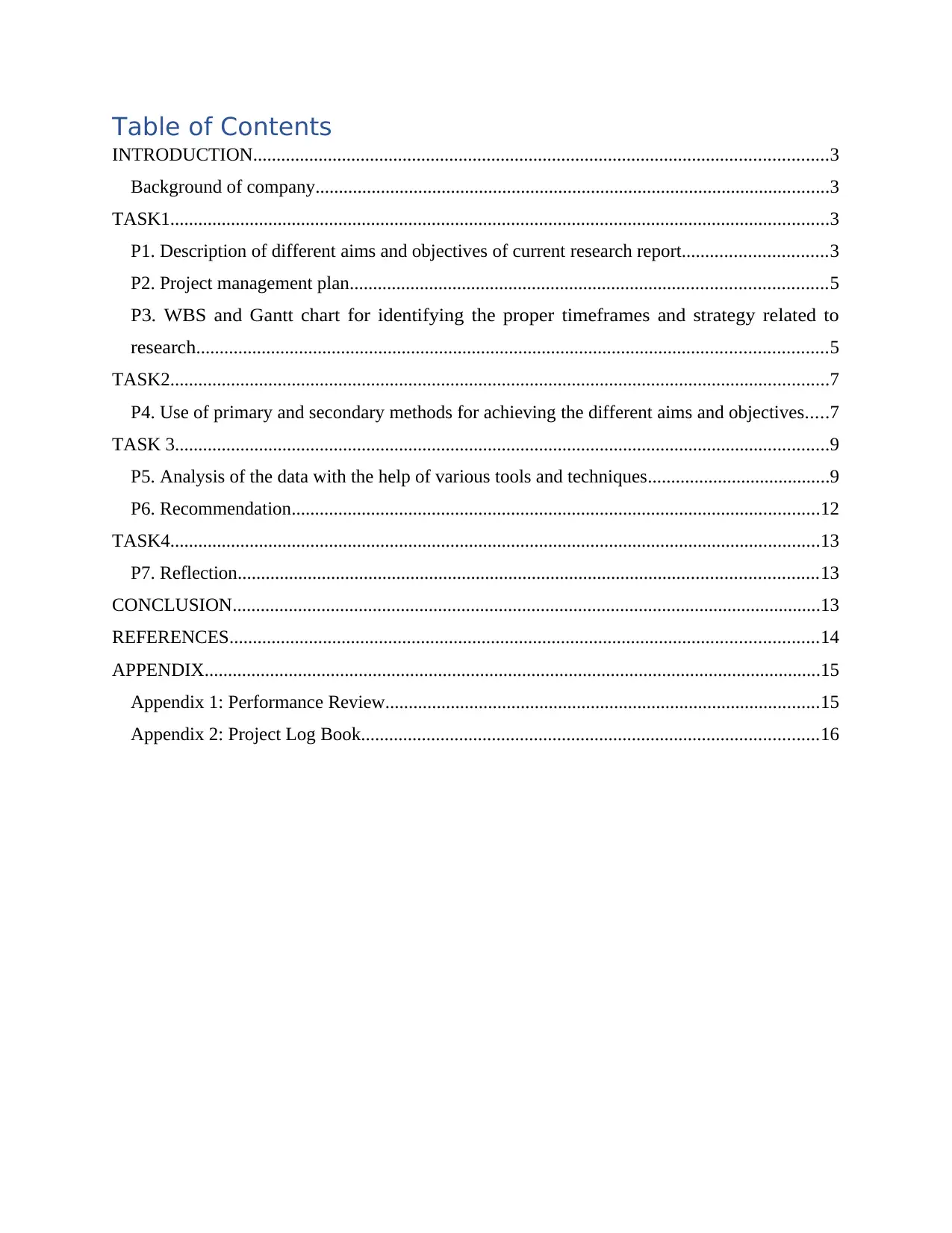
Table of Contents
INTRODUCTION...........................................................................................................................3
Background of company..............................................................................................................3
TASK1.............................................................................................................................................3
P1. Description of different aims and objectives of current research report...............................3
P2. Project management plan......................................................................................................5
P3. WBS and Gantt chart for identifying the proper timeframes and strategy related to
research.......................................................................................................................................5
TASK2.............................................................................................................................................7
P4. Use of primary and secondary methods for achieving the different aims and objectives.....7
TASK 3............................................................................................................................................9
P5. Analysis of the data with the help of various tools and techniques.......................................9
P6. Recommendation.................................................................................................................12
TASK4...........................................................................................................................................13
P7. Reflection............................................................................................................................13
CONCLUSION..............................................................................................................................13
REFERENCES..............................................................................................................................14
APPENDIX....................................................................................................................................15
Appendix 1: Performance Review.............................................................................................15
Appendix 2: Project Log Book..................................................................................................16
INTRODUCTION...........................................................................................................................3
Background of company..............................................................................................................3
TASK1.............................................................................................................................................3
P1. Description of different aims and objectives of current research report...............................3
P2. Project management plan......................................................................................................5
P3. WBS and Gantt chart for identifying the proper timeframes and strategy related to
research.......................................................................................................................................5
TASK2.............................................................................................................................................7
P4. Use of primary and secondary methods for achieving the different aims and objectives.....7
TASK 3............................................................................................................................................9
P5. Analysis of the data with the help of various tools and techniques.......................................9
P6. Recommendation.................................................................................................................12
TASK4...........................................................................................................................................13
P7. Reflection............................................................................................................................13
CONCLUSION..............................................................................................................................13
REFERENCES..............................................................................................................................14
APPENDIX....................................................................................................................................15
Appendix 1: Performance Review.............................................................................................15
Appendix 2: Project Log Book..................................................................................................16
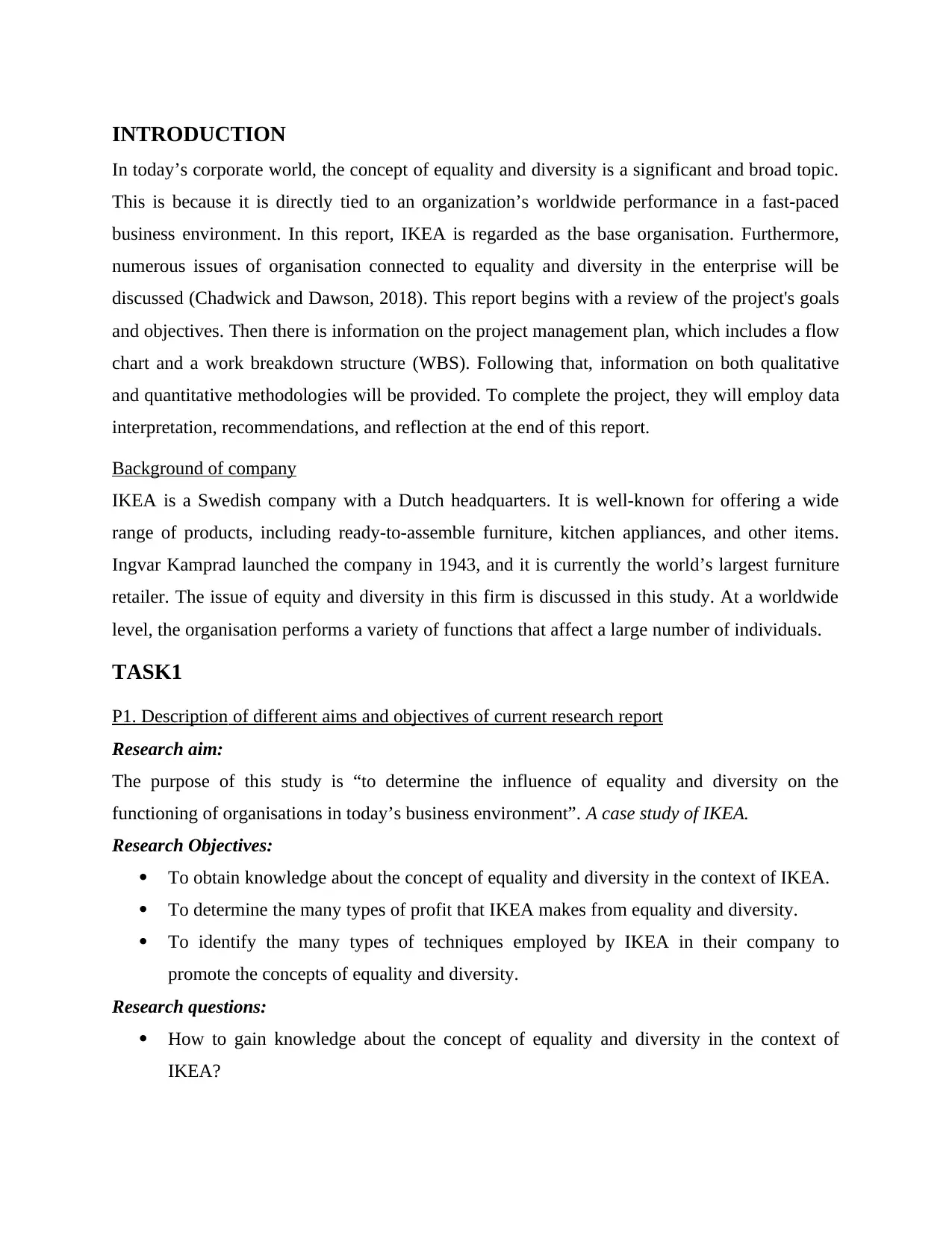
INTRODUCTION
In today’s corporate world, the concept of equality and diversity is a significant and broad topic.
This is because it is directly tied to an organization’s worldwide performance in a fast-paced
business environment. In this report, IKEA is regarded as the base organisation. Furthermore,
numerous issues of organisation connected to equality and diversity in the enterprise will be
discussed (Chadwick and Dawson, 2018). This report begins with a review of the project's goals
and objectives. Then there is information on the project management plan, which includes a flow
chart and a work breakdown structure (WBS). Following that, information on both qualitative
and quantitative methodologies will be provided. To complete the project, they will employ data
interpretation, recommendations, and reflection at the end of this report.
Background of company
IKEA is a Swedish company with a Dutch headquarters. It is well-known for offering a wide
range of products, including ready-to-assemble furniture, kitchen appliances, and other items.
Ingvar Kamprad launched the company in 1943, and it is currently the world’s largest furniture
retailer. The issue of equity and diversity in this firm is discussed in this study. At a worldwide
level, the organisation performs a variety of functions that affect a large number of individuals.
TASK1
P1. Description of different aims and objectives of current research report
Research aim:
The purpose of this study is “to determine the influence of equality and diversity on the
functioning of organisations in today’s business environment”. A case study of IKEA.
Research Objectives:
To obtain knowledge about the concept of equality and diversity in the context of IKEA.
To determine the many types of profit that IKEA makes from equality and diversity.
To identify the many types of techniques employed by IKEA in their company to
promote the concepts of equality and diversity.
Research questions:
How to gain knowledge about the concept of equality and diversity in the context of
IKEA?
In today’s corporate world, the concept of equality and diversity is a significant and broad topic.
This is because it is directly tied to an organization’s worldwide performance in a fast-paced
business environment. In this report, IKEA is regarded as the base organisation. Furthermore,
numerous issues of organisation connected to equality and diversity in the enterprise will be
discussed (Chadwick and Dawson, 2018). This report begins with a review of the project's goals
and objectives. Then there is information on the project management plan, which includes a flow
chart and a work breakdown structure (WBS). Following that, information on both qualitative
and quantitative methodologies will be provided. To complete the project, they will employ data
interpretation, recommendations, and reflection at the end of this report.
Background of company
IKEA is a Swedish company with a Dutch headquarters. It is well-known for offering a wide
range of products, including ready-to-assemble furniture, kitchen appliances, and other items.
Ingvar Kamprad launched the company in 1943, and it is currently the world’s largest furniture
retailer. The issue of equity and diversity in this firm is discussed in this study. At a worldwide
level, the organisation performs a variety of functions that affect a large number of individuals.
TASK1
P1. Description of different aims and objectives of current research report
Research aim:
The purpose of this study is “to determine the influence of equality and diversity on the
functioning of organisations in today’s business environment”. A case study of IKEA.
Research Objectives:
To obtain knowledge about the concept of equality and diversity in the context of IKEA.
To determine the many types of profit that IKEA makes from equality and diversity.
To identify the many types of techniques employed by IKEA in their company to
promote the concepts of equality and diversity.
Research questions:
How to gain knowledge about the concept of equality and diversity in the context of
IKEA?
⊘ This is a preview!⊘
Do you want full access?
Subscribe today to unlock all pages.

Trusted by 1+ million students worldwide
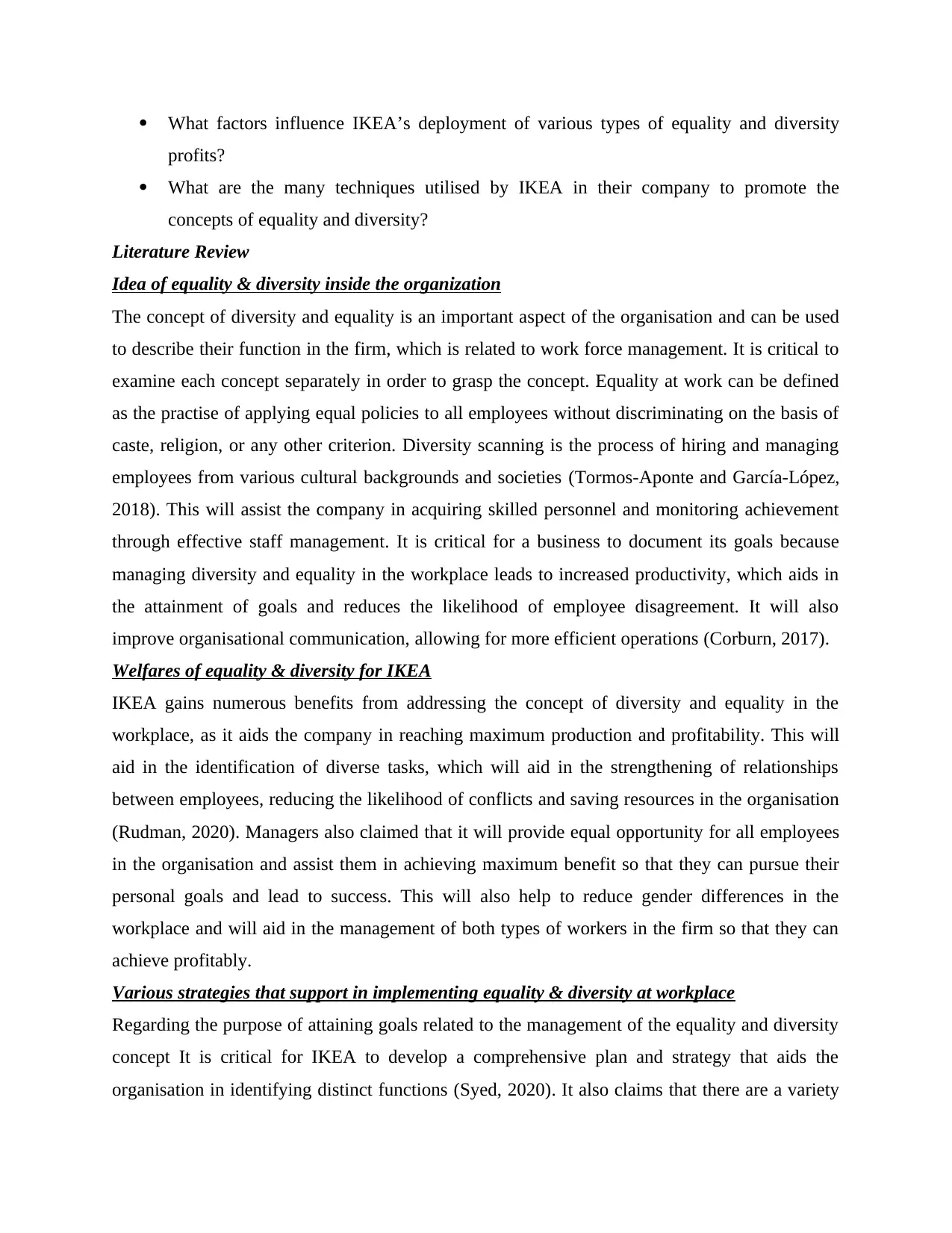
What factors influence IKEA’s deployment of various types of equality and diversity
profits?
What are the many techniques utilised by IKEA in their company to promote the
concepts of equality and diversity?
Literature Review
Idea of equality & diversity inside the organization
The concept of diversity and equality is an important aspect of the organisation and can be used
to describe their function in the firm, which is related to work force management. It is critical to
examine each concept separately in order to grasp the concept. Equality at work can be defined
as the practise of applying equal policies to all employees without discriminating on the basis of
caste, religion, or any other criterion. Diversity scanning is the process of hiring and managing
employees from various cultural backgrounds and societies (Tormos‐Aponte and García‐López,
2018). This will assist the company in acquiring skilled personnel and monitoring achievement
through effective staff management. It is critical for a business to document its goals because
managing diversity and equality in the workplace leads to increased productivity, which aids in
the attainment of goals and reduces the likelihood of employee disagreement. It will also
improve organisational communication, allowing for more efficient operations (Corburn, 2017).
Welfares of equality & diversity for IKEA
IKEA gains numerous benefits from addressing the concept of diversity and equality in the
workplace, as it aids the company in reaching maximum production and profitability. This will
aid in the identification of diverse tasks, which will aid in the strengthening of relationships
between employees, reducing the likelihood of conflicts and saving resources in the organisation
(Rudman, 2020). Managers also claimed that it will provide equal opportunity for all employees
in the organisation and assist them in achieving maximum benefit so that they can pursue their
personal goals and lead to success. This will also help to reduce gender differences in the
workplace and will aid in the management of both types of workers in the firm so that they can
achieve profitably.
Various strategies that support in implementing equality & diversity at workplace
Regarding the purpose of attaining goals related to the management of the equality and diversity
concept It is critical for IKEA to develop a comprehensive plan and strategy that aids the
organisation in identifying distinct functions (Syed, 2020). It also claims that there are a variety
profits?
What are the many techniques utilised by IKEA in their company to promote the
concepts of equality and diversity?
Literature Review
Idea of equality & diversity inside the organization
The concept of diversity and equality is an important aspect of the organisation and can be used
to describe their function in the firm, which is related to work force management. It is critical to
examine each concept separately in order to grasp the concept. Equality at work can be defined
as the practise of applying equal policies to all employees without discriminating on the basis of
caste, religion, or any other criterion. Diversity scanning is the process of hiring and managing
employees from various cultural backgrounds and societies (Tormos‐Aponte and García‐López,
2018). This will assist the company in acquiring skilled personnel and monitoring achievement
through effective staff management. It is critical for a business to document its goals because
managing diversity and equality in the workplace leads to increased productivity, which aids in
the attainment of goals and reduces the likelihood of employee disagreement. It will also
improve organisational communication, allowing for more efficient operations (Corburn, 2017).
Welfares of equality & diversity for IKEA
IKEA gains numerous benefits from addressing the concept of diversity and equality in the
workplace, as it aids the company in reaching maximum production and profitability. This will
aid in the identification of diverse tasks, which will aid in the strengthening of relationships
between employees, reducing the likelihood of conflicts and saving resources in the organisation
(Rudman, 2020). Managers also claimed that it will provide equal opportunity for all employees
in the organisation and assist them in achieving maximum benefit so that they can pursue their
personal goals and lead to success. This will also help to reduce gender differences in the
workplace and will aid in the management of both types of workers in the firm so that they can
achieve profitably.
Various strategies that support in implementing equality & diversity at workplace
Regarding the purpose of attaining goals related to the management of the equality and diversity
concept It is critical for IKEA to develop a comprehensive plan and strategy that aids the
organisation in identifying distinct functions (Syed, 2020). It also claims that there are a variety
Paraphrase This Document
Need a fresh take? Get an instant paraphrase of this document with our AI Paraphraser
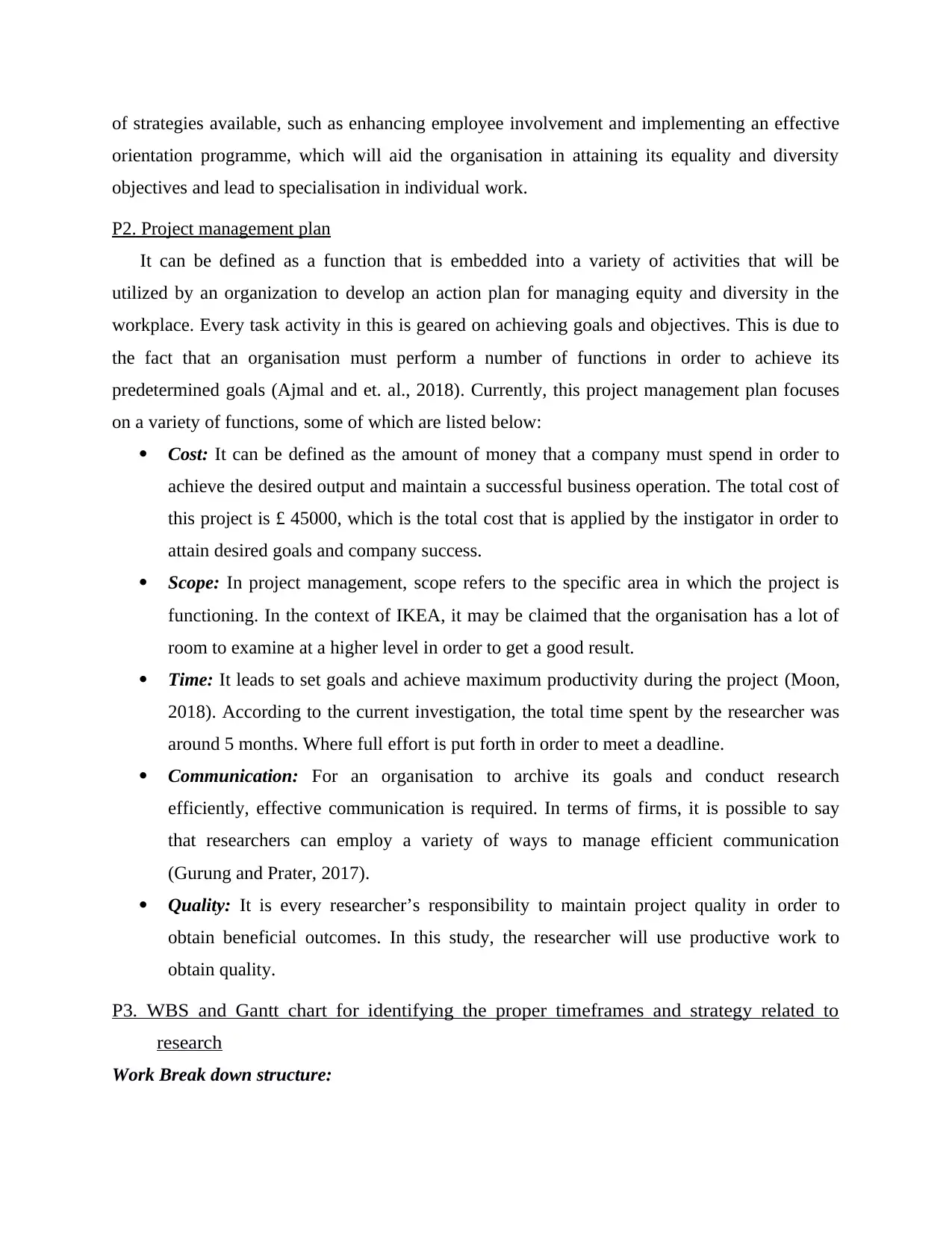
of strategies available, such as enhancing employee involvement and implementing an effective
orientation programme, which will aid the organisation in attaining its equality and diversity
objectives and lead to specialisation in individual work.
P2. Project management plan
It can be defined as a function that is embedded into a variety of activities that will be
utilized by an organization to develop an action plan for managing equity and diversity in the
workplace. Every task activity in this is geared on achieving goals and objectives. This is due to
the fact that an organisation must perform a number of functions in order to achieve its
predetermined goals (Ajmal and et. al., 2018). Currently, this project management plan focuses
on a variety of functions, some of which are listed below:
Cost: It can be defined as the amount of money that a company must spend in order to
achieve the desired output and maintain a successful business operation. The total cost of
this project is £ 45000, which is the total cost that is applied by the instigator in order to
attain desired goals and company success.
Scope: In project management, scope refers to the specific area in which the project is
functioning. In the context of IKEA, it may be claimed that the organisation has a lot of
room to examine at a higher level in order to get a good result.
Time: It leads to set goals and achieve maximum productivity during the project (Moon,
2018). According to the current investigation, the total time spent by the researcher was
around 5 months. Where full effort is put forth in order to meet a deadline.
Communication: For an organisation to archive its goals and conduct research
efficiently, effective communication is required. In terms of firms, it is possible to say
that researchers can employ a variety of ways to manage efficient communication
(Gurung and Prater, 2017).
Quality: It is every researcher’s responsibility to maintain project quality in order to
obtain beneficial outcomes. In this study, the researcher will use productive work to
obtain quality.
P3. WBS and Gantt chart for identifying the proper timeframes and strategy related to
research
Work Break down structure:
orientation programme, which will aid the organisation in attaining its equality and diversity
objectives and lead to specialisation in individual work.
P2. Project management plan
It can be defined as a function that is embedded into a variety of activities that will be
utilized by an organization to develop an action plan for managing equity and diversity in the
workplace. Every task activity in this is geared on achieving goals and objectives. This is due to
the fact that an organisation must perform a number of functions in order to achieve its
predetermined goals (Ajmal and et. al., 2018). Currently, this project management plan focuses
on a variety of functions, some of which are listed below:
Cost: It can be defined as the amount of money that a company must spend in order to
achieve the desired output and maintain a successful business operation. The total cost of
this project is £ 45000, which is the total cost that is applied by the instigator in order to
attain desired goals and company success.
Scope: In project management, scope refers to the specific area in which the project is
functioning. In the context of IKEA, it may be claimed that the organisation has a lot of
room to examine at a higher level in order to get a good result.
Time: It leads to set goals and achieve maximum productivity during the project (Moon,
2018). According to the current investigation, the total time spent by the researcher was
around 5 months. Where full effort is put forth in order to meet a deadline.
Communication: For an organisation to archive its goals and conduct research
efficiently, effective communication is required. In terms of firms, it is possible to say
that researchers can employ a variety of ways to manage efficient communication
(Gurung and Prater, 2017).
Quality: It is every researcher’s responsibility to maintain project quality in order to
obtain beneficial outcomes. In this study, the researcher will use productive work to
obtain quality.
P3. WBS and Gantt chart for identifying the proper timeframes and strategy related to
research
Work Break down structure:
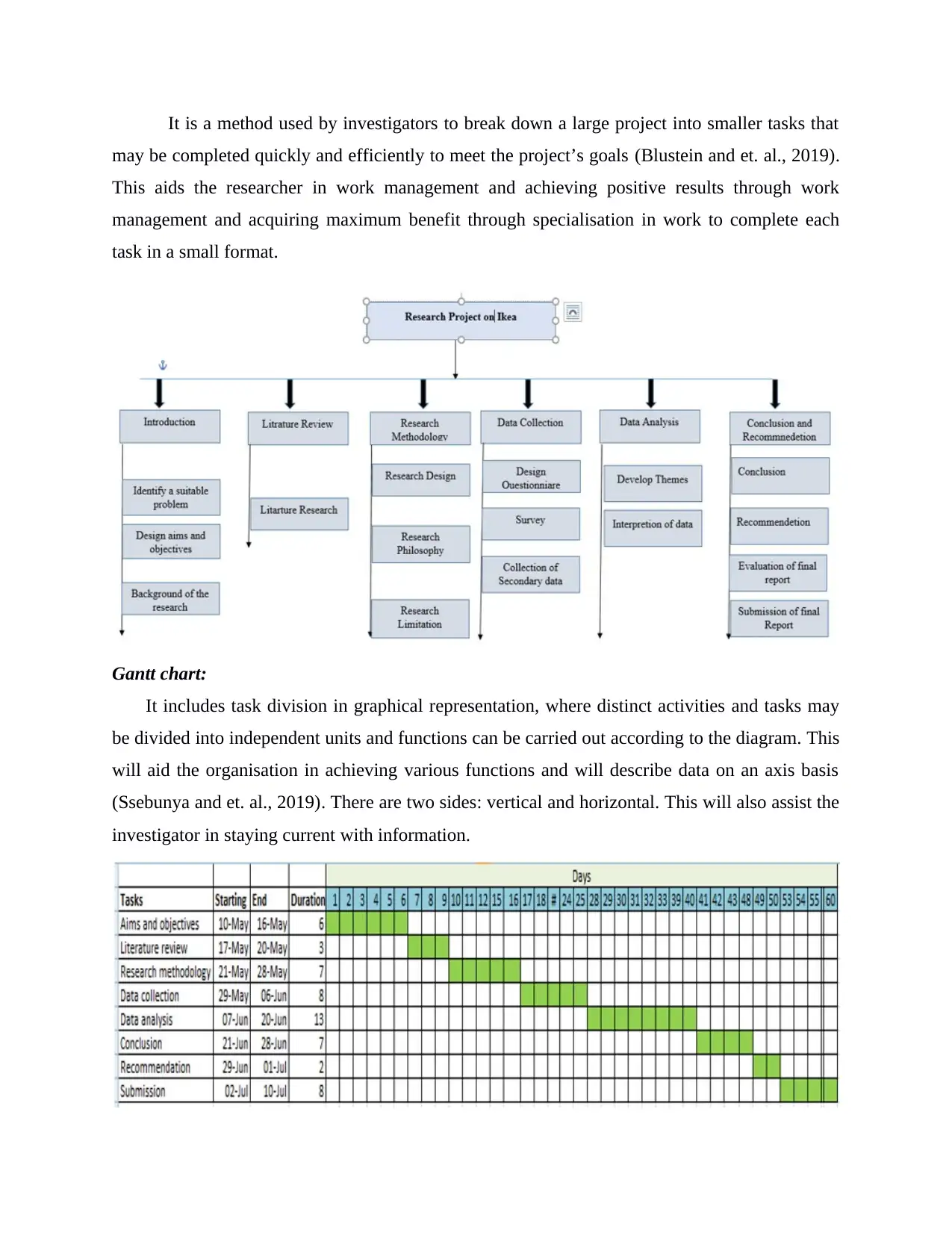
It is a method used by investigators to break down a large project into smaller tasks that
may be completed quickly and efficiently to meet the project’s goals (Blustein and et. al., 2019).
This aids the researcher in work management and achieving positive results through work
management and acquiring maximum benefit through specialisation in work to complete each
task in a small format.
Gantt chart:
It includes task division in graphical representation, where distinct activities and tasks may
be divided into independent units and functions can be carried out according to the diagram. This
will aid the organisation in achieving various functions and will describe data on an axis basis
(Ssebunya and et. al., 2019). There are two sides: vertical and horizontal. This will also assist the
investigator in staying current with information.
may be completed quickly and efficiently to meet the project’s goals (Blustein and et. al., 2019).
This aids the researcher in work management and achieving positive results through work
management and acquiring maximum benefit through specialisation in work to complete each
task in a small format.
Gantt chart:
It includes task division in graphical representation, where distinct activities and tasks may
be divided into independent units and functions can be carried out according to the diagram. This
will aid the organisation in achieving various functions and will describe data on an axis basis
(Ssebunya and et. al., 2019). There are two sides: vertical and horizontal. This will also assist the
investigator in staying current with information.
⊘ This is a preview!⊘
Do you want full access?
Subscribe today to unlock all pages.

Trusted by 1+ million students worldwide
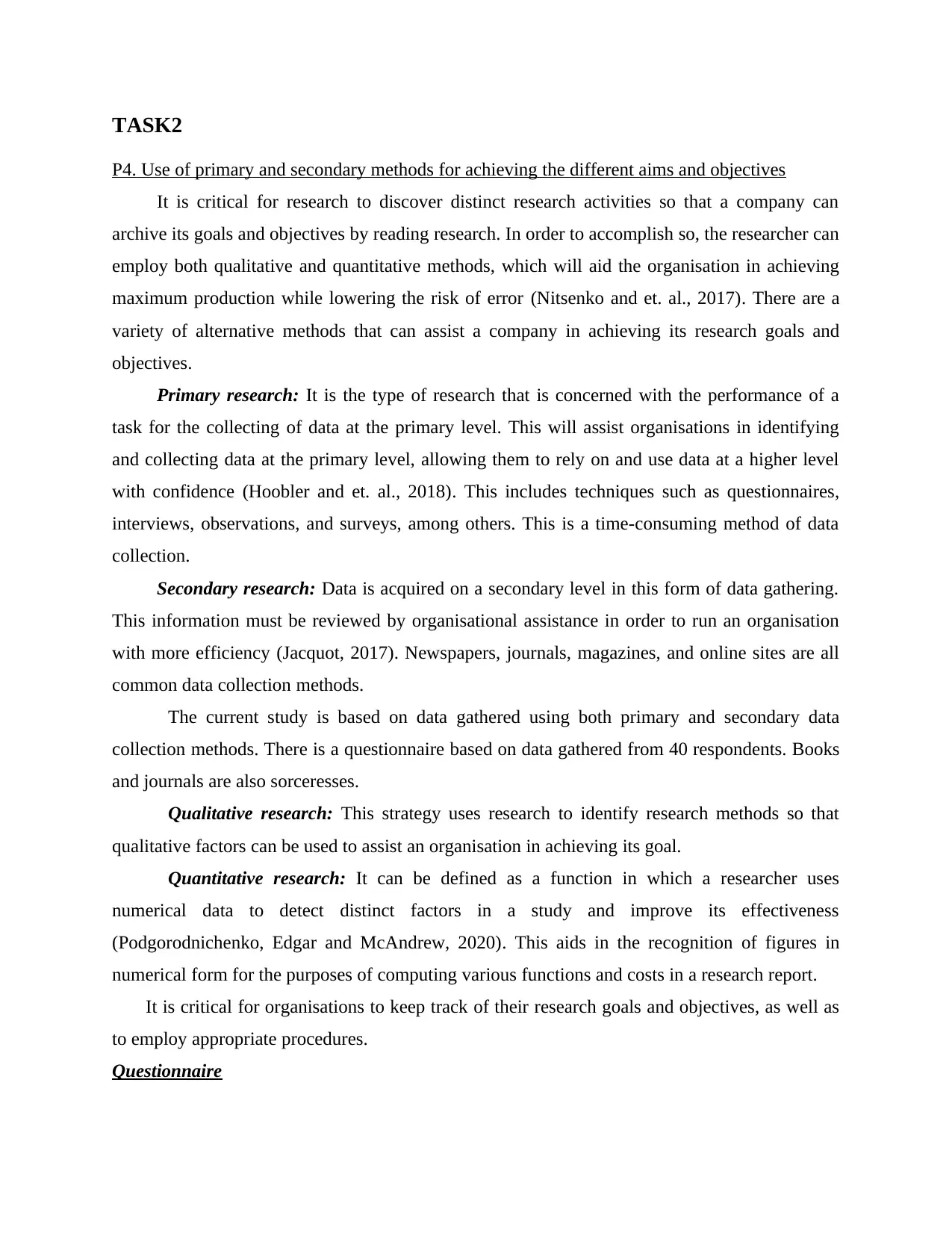
TASK2
P4. Use of primary and secondary methods for achieving the different aims and objectives
It is critical for research to discover distinct research activities so that a company can
archive its goals and objectives by reading research. In order to accomplish so, the researcher can
employ both qualitative and quantitative methods, which will aid the organisation in achieving
maximum production while lowering the risk of error (Nitsenko and et. al., 2017). There are a
variety of alternative methods that can assist a company in achieving its research goals and
objectives.
Primary research: It is the type of research that is concerned with the performance of a
task for the collecting of data at the primary level. This will assist organisations in identifying
and collecting data at the primary level, allowing them to rely on and use data at a higher level
with confidence (Hoobler and et. al., 2018). This includes techniques such as questionnaires,
interviews, observations, and surveys, among others. This is a time-consuming method of data
collection.
Secondary research: Data is acquired on a secondary level in this form of data gathering.
This information must be reviewed by organisational assistance in order to run an organisation
with more efficiency (Jacquot, 2017). Newspapers, journals, magazines, and online sites are all
common data collection methods.
The current study is based on data gathered using both primary and secondary data
collection methods. There is a questionnaire based on data gathered from 40 respondents. Books
and journals are also sorceresses.
Qualitative research: This strategy uses research to identify research methods so that
qualitative factors can be used to assist an organisation in achieving its goal.
Quantitative research: It can be defined as a function in which a researcher uses
numerical data to detect distinct factors in a study and improve its effectiveness
(Podgorodnichenko, Edgar and McAndrew, 2020). This aids in the recognition of figures in
numerical form for the purposes of computing various functions and costs in a research report.
It is critical for organisations to keep track of their research goals and objectives, as well as
to employ appropriate procedures.
Questionnaire
P4. Use of primary and secondary methods for achieving the different aims and objectives
It is critical for research to discover distinct research activities so that a company can
archive its goals and objectives by reading research. In order to accomplish so, the researcher can
employ both qualitative and quantitative methods, which will aid the organisation in achieving
maximum production while lowering the risk of error (Nitsenko and et. al., 2017). There are a
variety of alternative methods that can assist a company in achieving its research goals and
objectives.
Primary research: It is the type of research that is concerned with the performance of a
task for the collecting of data at the primary level. This will assist organisations in identifying
and collecting data at the primary level, allowing them to rely on and use data at a higher level
with confidence (Hoobler and et. al., 2018). This includes techniques such as questionnaires,
interviews, observations, and surveys, among others. This is a time-consuming method of data
collection.
Secondary research: Data is acquired on a secondary level in this form of data gathering.
This information must be reviewed by organisational assistance in order to run an organisation
with more efficiency (Jacquot, 2017). Newspapers, journals, magazines, and online sites are all
common data collection methods.
The current study is based on data gathered using both primary and secondary data
collection methods. There is a questionnaire based on data gathered from 40 respondents. Books
and journals are also sorceresses.
Qualitative research: This strategy uses research to identify research methods so that
qualitative factors can be used to assist an organisation in achieving its goal.
Quantitative research: It can be defined as a function in which a researcher uses
numerical data to detect distinct factors in a study and improve its effectiveness
(Podgorodnichenko, Edgar and McAndrew, 2020). This aids in the recognition of figures in
numerical form for the purposes of computing various functions and costs in a research report.
It is critical for organisations to keep track of their research goals and objectives, as well as
to employ appropriate procedures.
Questionnaire
Paraphrase This Document
Need a fresh take? Get an instant paraphrase of this document with our AI Paraphraser
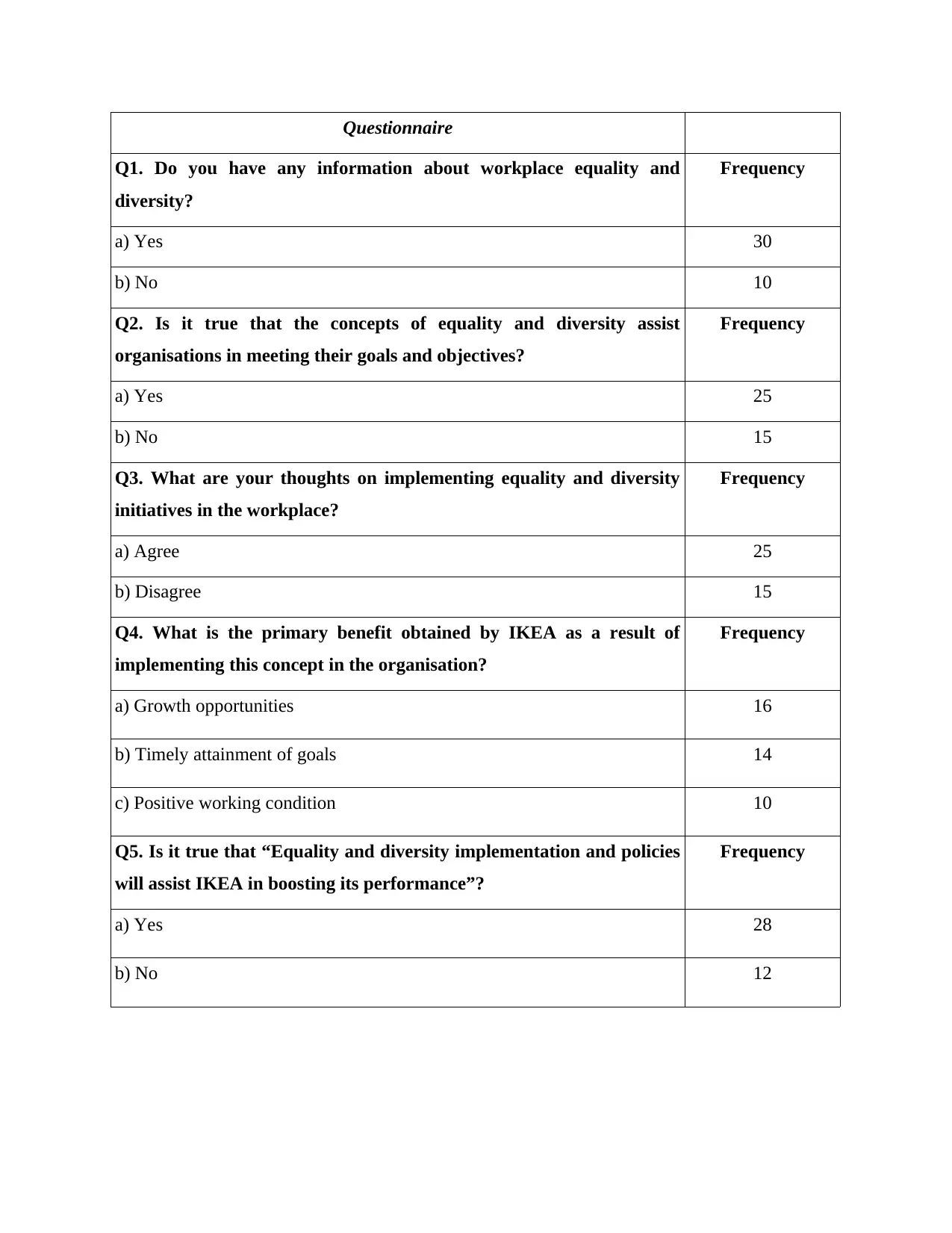
Questionnaire
Q1. Do you have any information about workplace equality and
diversity?
Frequency
a) Yes 30
b) No 10
Q2. Is it true that the concepts of equality and diversity assist
organisations in meeting their goals and objectives?
Frequency
a) Yes 25
b) No 15
Q3. What are your thoughts on implementing equality and diversity
initiatives in the workplace?
Frequency
a) Agree 25
b) Disagree 15
Q4. What is the primary benefit obtained by IKEA as a result of
implementing this concept in the organisation?
Frequency
a) Growth opportunities 16
b) Timely attainment of goals 14
c) Positive working condition 10
Q5. Is it true that “Equality and diversity implementation and policies
will assist IKEA in boosting its performance”?
Frequency
a) Yes 28
b) No 12
Q1. Do you have any information about workplace equality and
diversity?
Frequency
a) Yes 30
b) No 10
Q2. Is it true that the concepts of equality and diversity assist
organisations in meeting their goals and objectives?
Frequency
a) Yes 25
b) No 15
Q3. What are your thoughts on implementing equality and diversity
initiatives in the workplace?
Frequency
a) Agree 25
b) Disagree 15
Q4. What is the primary benefit obtained by IKEA as a result of
implementing this concept in the organisation?
Frequency
a) Growth opportunities 16
b) Timely attainment of goals 14
c) Positive working condition 10
Q5. Is it true that “Equality and diversity implementation and policies
will assist IKEA in boosting its performance”?
Frequency
a) Yes 28
b) No 12
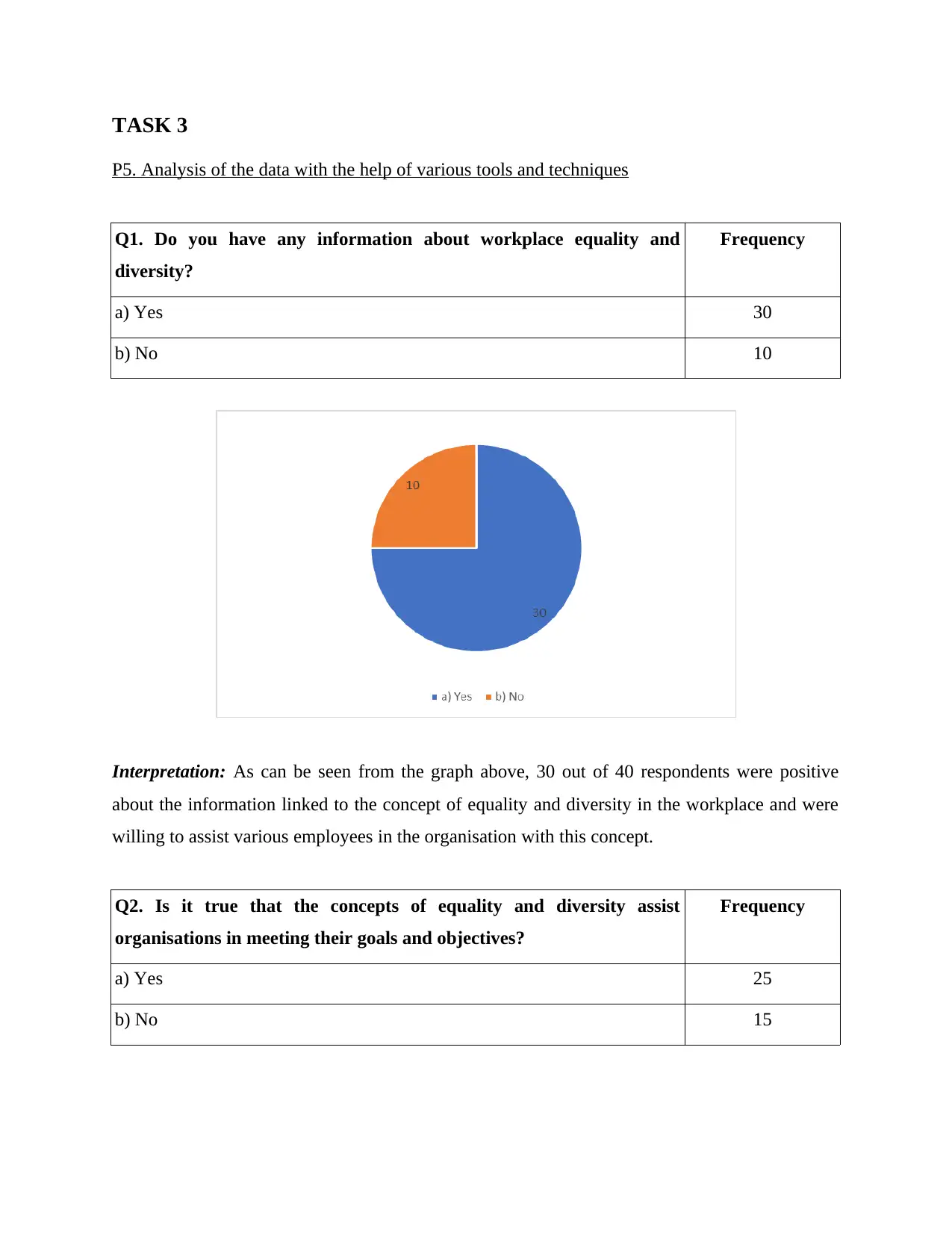
TASK 3
P5. Analysis of the data with the help of various tools and techniques
Q1. Do you have any information about workplace equality and
diversity?
Frequency
a) Yes 30
b) No 10
Interpretation: As can be seen from the graph above, 30 out of 40 respondents were positive
about the information linked to the concept of equality and diversity in the workplace and were
willing to assist various employees in the organisation with this concept.
Q2. Is it true that the concepts of equality and diversity assist
organisations in meeting their goals and objectives?
Frequency
a) Yes 25
b) No 15
P5. Analysis of the data with the help of various tools and techniques
Q1. Do you have any information about workplace equality and
diversity?
Frequency
a) Yes 30
b) No 10
Interpretation: As can be seen from the graph above, 30 out of 40 respondents were positive
about the information linked to the concept of equality and diversity in the workplace and were
willing to assist various employees in the organisation with this concept.
Q2. Is it true that the concepts of equality and diversity assist
organisations in meeting their goals and objectives?
Frequency
a) Yes 25
b) No 15
⊘ This is a preview!⊘
Do you want full access?
Subscribe today to unlock all pages.

Trusted by 1+ million students worldwide
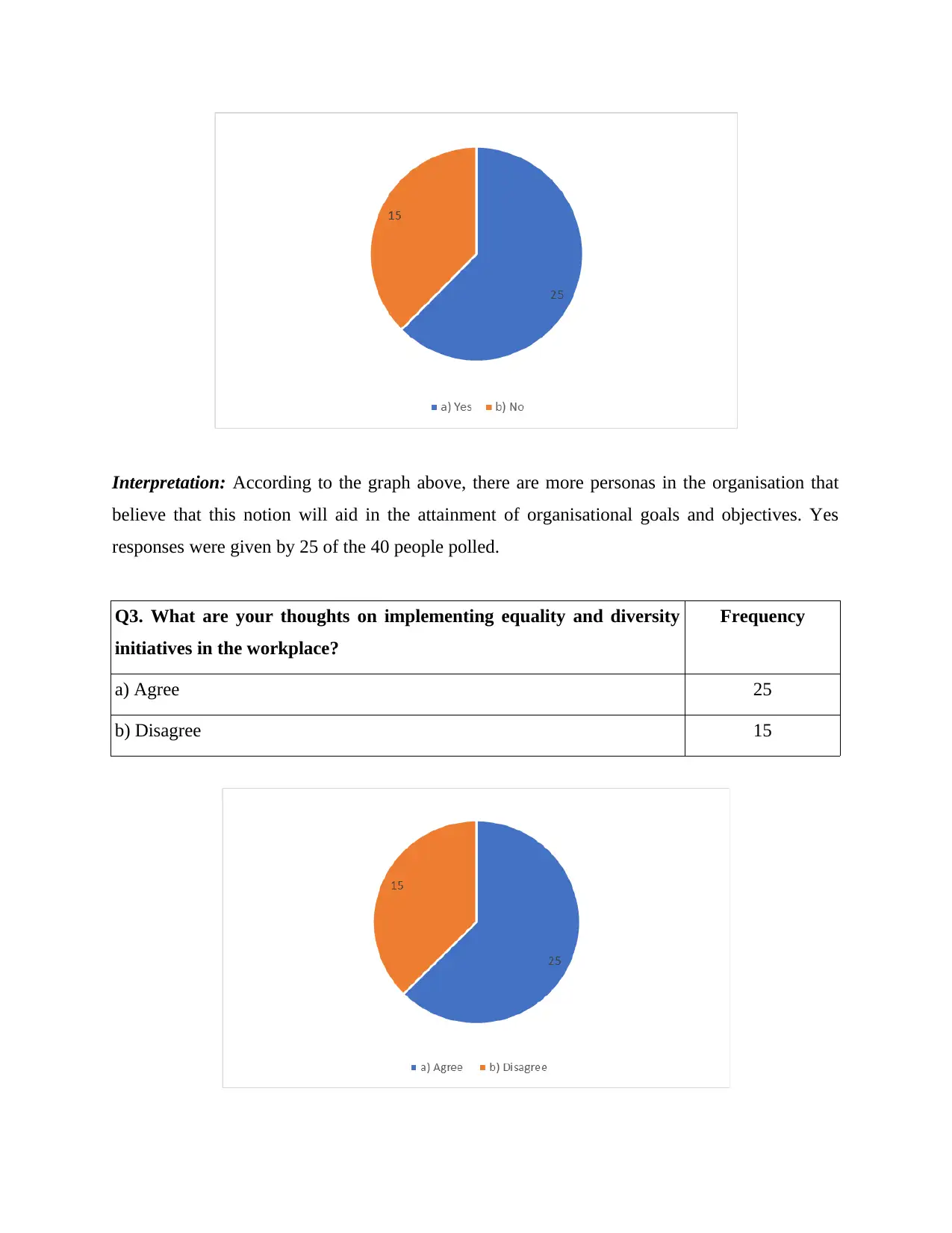
Interpretation: According to the graph above, there are more personas in the organisation that
believe that this notion will aid in the attainment of organisational goals and objectives. Yes
responses were given by 25 of the 40 people polled.
Q3. What are your thoughts on implementing equality and diversity
initiatives in the workplace?
Frequency
a) Agree 25
b) Disagree 15
believe that this notion will aid in the attainment of organisational goals and objectives. Yes
responses were given by 25 of the 40 people polled.
Q3. What are your thoughts on implementing equality and diversity
initiatives in the workplace?
Frequency
a) Agree 25
b) Disagree 15
Paraphrase This Document
Need a fresh take? Get an instant paraphrase of this document with our AI Paraphraser
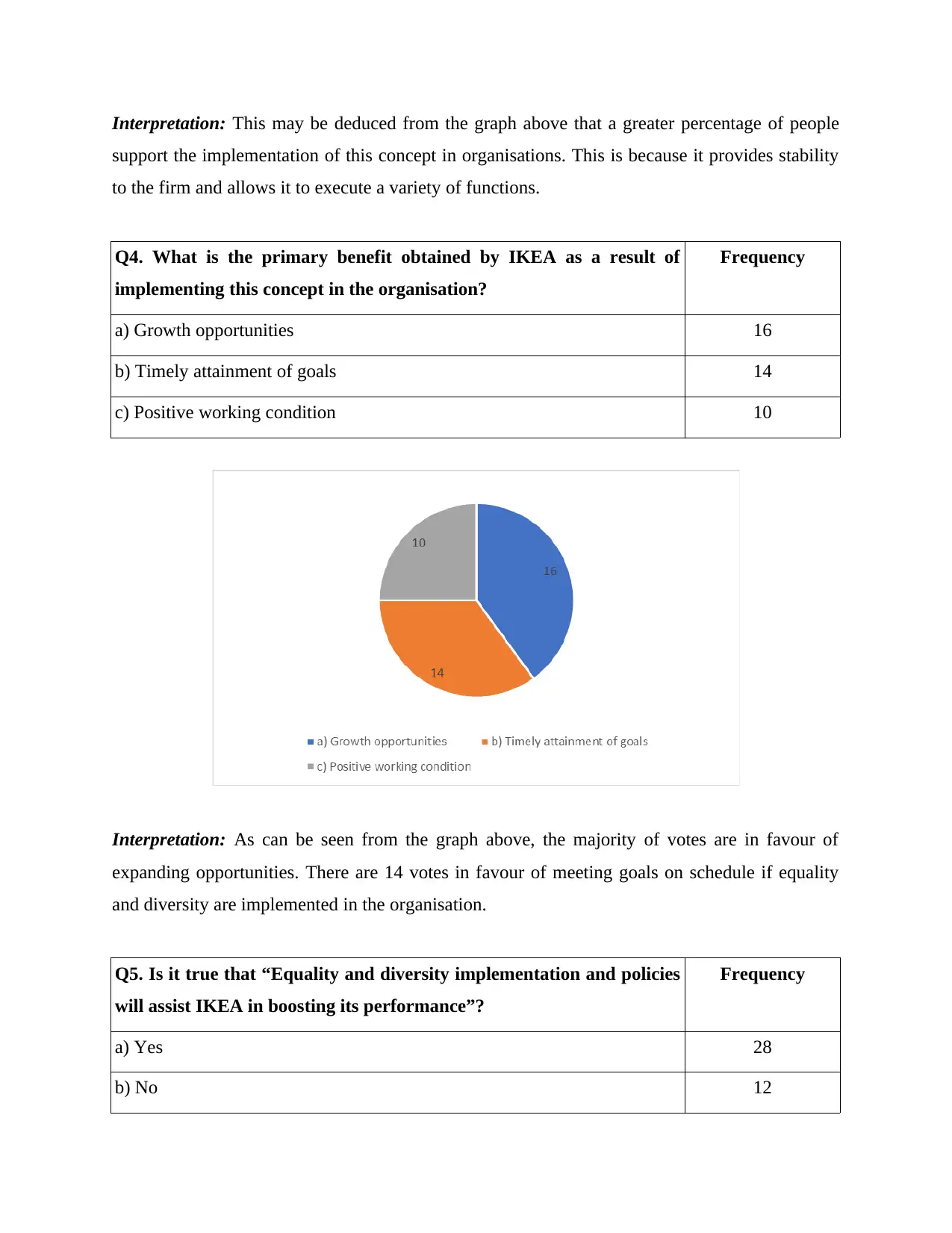
Interpretation: This may be deduced from the graph above that a greater percentage of people
support the implementation of this concept in organisations. This is because it provides stability
to the firm and allows it to execute a variety of functions.
Q4. What is the primary benefit obtained by IKEA as a result of
implementing this concept in the organisation?
Frequency
a) Growth opportunities 16
b) Timely attainment of goals 14
c) Positive working condition 10
Interpretation: As can be seen from the graph above, the majority of votes are in favour of
expanding opportunities. There are 14 votes in favour of meeting goals on schedule if equality
and diversity are implemented in the organisation.
Q5. Is it true that “Equality and diversity implementation and policies
will assist IKEA in boosting its performance”?
Frequency
a) Yes 28
b) No 12
support the implementation of this concept in organisations. This is because it provides stability
to the firm and allows it to execute a variety of functions.
Q4. What is the primary benefit obtained by IKEA as a result of
implementing this concept in the organisation?
Frequency
a) Growth opportunities 16
b) Timely attainment of goals 14
c) Positive working condition 10
Interpretation: As can be seen from the graph above, the majority of votes are in favour of
expanding opportunities. There are 14 votes in favour of meeting goals on schedule if equality
and diversity are implemented in the organisation.
Q5. Is it true that “Equality and diversity implementation and policies
will assist IKEA in boosting its performance”?
Frequency
a) Yes 28
b) No 12
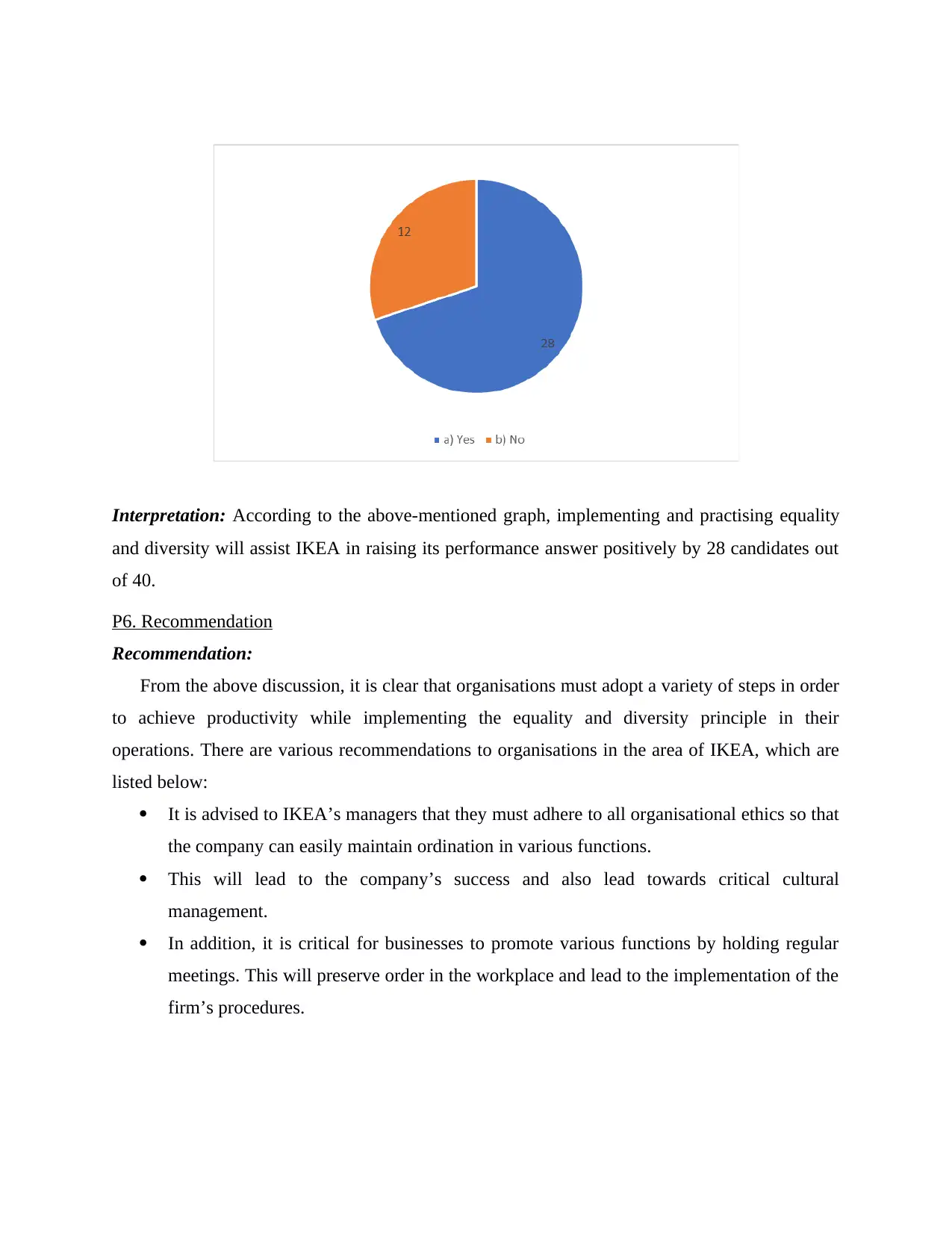
Interpretation: According to the above-mentioned graph, implementing and practising equality
and diversity will assist IKEA in raising its performance answer positively by 28 candidates out
of 40.
P6. Recommendation
Recommendation:
From the above discussion, it is clear that organisations must adopt a variety of steps in order
to achieve productivity while implementing the equality and diversity principle in their
operations. There are various recommendations to organisations in the area of IKEA, which are
listed below:
It is advised to IKEA’s managers that they must adhere to all organisational ethics so that
the company can easily maintain ordination in various functions.
This will lead to the company’s success and also lead towards critical cultural
management.
In addition, it is critical for businesses to promote various functions by holding regular
meetings. This will preserve order in the workplace and lead to the implementation of the
firm’s procedures.
and diversity will assist IKEA in raising its performance answer positively by 28 candidates out
of 40.
P6. Recommendation
Recommendation:
From the above discussion, it is clear that organisations must adopt a variety of steps in order
to achieve productivity while implementing the equality and diversity principle in their
operations. There are various recommendations to organisations in the area of IKEA, which are
listed below:
It is advised to IKEA’s managers that they must adhere to all organisational ethics so that
the company can easily maintain ordination in various functions.
This will lead to the company’s success and also lead towards critical cultural
management.
In addition, it is critical for businesses to promote various functions by holding regular
meetings. This will preserve order in the workplace and lead to the implementation of the
firm’s procedures.
⊘ This is a preview!⊘
Do you want full access?
Subscribe today to unlock all pages.

Trusted by 1+ million students worldwide
1 out of 19
Related Documents
Your All-in-One AI-Powered Toolkit for Academic Success.
+13062052269
info@desklib.com
Available 24*7 on WhatsApp / Email
![[object Object]](/_next/static/media/star-bottom.7253800d.svg)
Unlock your academic potential
Copyright © 2020–2025 A2Z Services. All Rights Reserved. Developed and managed by ZUCOL.





